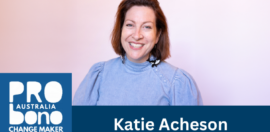Prevention Is Better Than a Cure

28 July 2016 at 10:43 am
Professor Nicholas Cowdery AM QC is the chair of the White Ribbon Australia board. He talks about the board’s commitment to White Ribbon’s vision and purpose in this month’s Evolving Chair.

White Ribbon is the world’s largest movement of men and boys working to end men’s violence against women and girls and promote gender equality. As part of this global movement, White Ribbon Australia aims to create an Australian society in which all women can live in safety, free from violence and abuse.
Cowdery, who has been a White Ribbon Ambassador since 2009 and joined the board in February, said he was honoured to be part of an organisation that focuses on such an important issue and is driving critical change.
Prior to joining the Not for Profit board, Cowdery had extensive experience as a barrister in a career spanning more than four decades and was the director of Public Prosecutions for New South Wales, the largest prosecuting agency in Australia, from 1994 to 2011.
In addition, he holds several honorary university academic positions, consults for a number of organisations including The United Nations, and is a member of the National Human Rights Committee of the Law Council of Australia, the Institute of Criminology Advisory Committee, the Criminal Law Committee of the NSW Bar Association and the NSW Sentencing Council. He was inaugural co-chair of the Human Rights Institute of the International Bar Association.
In 2003 he was appointed a Member in the Order of Australia for service to the development and practice of criminal law, and for fostering international relations in the area of human rights.
In this month’s Evolving Chair, Cowdery talks about making the move from dealing with the consequences of violence against women to addressing prevention, the issues of gender balance for a board and why communication is key.
What attracted you to White Ribbon’s board?
I have been a White Ribbon Ambassador since 2009 when I was director of Public Prosecutions for NSW and a strong supporter of its vision, purpose and messages. I was asked to join the board and, now being retired from the DPP position (although still active in many respects concerning criminal justice and other matters), thought it was a significant way to apply my knowledge and skills to assist White Ribbon to advance. I was also interested to move from dealing with the consequences of violence against and abuse of women (and children) to addressing prevention (which is always better than a cure).
What is the structure of your board?
The constitution provides for up to nine directors (all presently filled). The directors bring a mix of skills and expertise across all aspects of governance, including knowledge and capability in the areas of domestic and family violence and gender equality. They are nationally representative, with members at present from all states and territories other than Tasmania and the Northern Territory. The officers are the chairman and treasurer. The constitution requires at least 50 per cent male directors who are White Ribbon Ambassadors. They are individually appointed for their expertise, not as representatives of any sectors or organisations.
What are your board’s current priorities?
White Ribbon Australia has recently released its new Strategic Framework 2016 to 2019 which builds on the strengths of the White Ribbon primary prevention social movement. The key priorities are: leadership through the support and enablement of men (working alongside women) to stand up, speak out and act to stop violence against women (VAW), community engagement and action to accelerate social change, collaborative influence through working alongside other organisations and groups committed to the prevention of VAW, and organisational sustainability and agility. In the immediate term, appropriate levels of ongoing funding for White Ribbon’s successful programs (it receives only a very small amount of government funding) is an ongoing priority, linked with enhancing staffing levels and facilities. Cooperative engagement with other agencies in the sector is also a high priority.
Is gender balance an issue for your board?
Given the unique purpose of White Ribbon Australia to engage men to make women’s safety a men’s issue too, this is reflected in the composition of the board where the majority of directors must be male White Ribbon Ambassadors. There is currently one female director (who is the treasurer) and a female CEO, so gender balance is an issue. It will figure largely when a vacancy needs to be filled.
What has been the highlight of your work with this board?
I have had only six months’ experience, but I have been strongly impressed by the commitment to White Ribbon’s vision and purpose and the enthusiasm board members have shown for active engagement in its work. There is an excellent working relationship with the CEO, Libby Davies, and the staff at all levels.
What are the key sector issues that are being discussed at board level?
Ensuring there is sufficient support for effective prevention work as well as services for women and their children who experience violence. Coordination and cooperation with the work being done by other agencies in the sector, recognising the limits on resources available overall and the value of maximising the impact of programs that have been tried, tested and found effective in prevention.
Does your board believe collaboration between organisations is important?
Yes, it is vital and we work actively to improve relationships with like-minded organisations, recognising the particular remit of each. It is important to avoid overlapping with the activities of others and “reinventing the wheel”.
How important is the board’s relationship with the chief executive officer?
It is essential to have an excellent working and personal relationship with the CEO and we are fortunate to enjoy that in White Ribbon Australia. There is a high level of trust and confidence in both directions and we work to ensure that continues.
Do you have any advice on building that relationship?
Communication is the key – so that all parties are aware of the thinking and actions of others and can maximise the benefit of cooperative action. Frank and open discussion of all relevant issues is the best way of achieving that.







